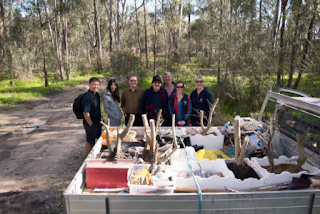Hi All,
The warm days and the colder nights mean a great show of Autumn colours around town and in the Bonsai collection. This is a good reminder to move your frost prone bonsai to their winter protected homes and to start preparing for the winter months by cleaning away fallen leaves and debris and final feedings before winter sets in. Check your watering system/regime and start to reduce the water as required. Stop pruning your deciduous flowering trees now, these have started forming the buds for the springtime.
This month the club meeting is based on re-potting conifers and of course working on any trees you wish to bring in.
The AABC seminar is on in Canberra next month and this is your last chance to buy tickets. If you would like more info please email. Look forward to seeing you all on Saturday.
Cheers
The Jade Tree—Crassula Arborescens
The Jade is a native of South Africa, where it can reach 3 metres (10ft) in height. It has thick branches and smooth rounded fleshy leaves. There are a number of species. I have tried the common dark green and a striking lighter green variety with red tinges on new stalks and leaves. I find the latter is better for developing the foliage. The darker variety does not thicken up so well. The jade is a succulent so does not require as much water as other species. This said, I now water mine at the same time as all my other trees and it does equally as well less water. They are not frost tolerant so need protection during the winter. Just under the eves seems to be enough. They do drop leaves during winter and you may find some wrinkling—might need a little extra water.
Feeding
I feed the same as all my other trees with fish emulsion and powerfeed.
Re-potting
Every 2-3 years is fine. I just use my usual mix with a little extra stone for drainage. Being a succulent you do
not want root rot
Wiring
I find they take wiring well
Pruning
Major pruning can be done throughout the summer. To thicken the branches pinch back the shoots. Like the Olive they have a tendency to put out shoots along the trunk where they are not required and at the base. Pinch these out instead of cutting. Remove leaves under branches to develop the pads.
Getting new trees
Being succulent they strike from cuttings easily. Even I can get them to strike. I find they are slower to develop in a pot. The quickest way to get a tree is if you are able to find an old specimen. Look at it carefully and see if one of the side branches is a potential bonsai. If you find one cut it off, watching the length of the trunk. Five (5) longitudinal cuts approx 2cm long have to be made around the base of the trunk and from these cuts the roots will strike. Place in a sandy mixture an hopefully in time you will have a nice nebari. The branches and the foliage pads will still have to be developed.
Styles
Jade lends itself best to upright styles of informal upright and multiple trunk. If a good specimen can be found it is possible to have a cascade.
FOR SALE - CLUB DISPLAY STANDS
The Club stands which have been used for display purposes since we hosted the National Convention in 1999 are up for sale at the princely sum of $5 each.
There are 10 in all – $ are alreadry sold.
They range in height from 820mm to 1255mm, with tops ranging from 350 x 350mm to 580 x 490mm.
Not suitable for leaving out in the weather but will last a long time in semiprotected areas such as under covered patios or on veranda's.
First in best dressed – we can deliver in Wagga Wagga.
Please contact the club for further details













